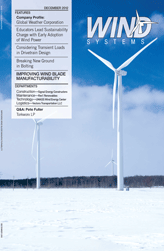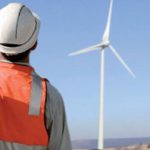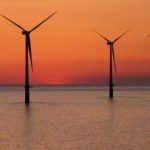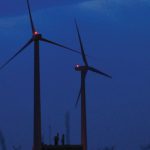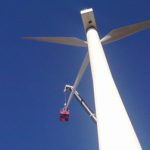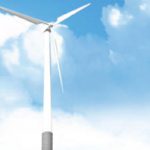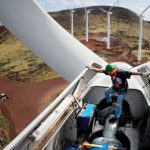As the United States depletes its fossil fuel reserves, it is beginning to look for alternative energy sources, and wind power is a viable option. According to the United States Department of Energy, the U.S. has enough aggregate wind resources to generate electricity for every home and business in the nation.
When many Americans think of wind power, images of turbines dotting the California coastline or across open spaces in Texas and Iowa immediately come to mind. Thanks to the efforts of educators in the Southeast, however, this region is becoming a leader in promoting the long-term benefits of wind energy and implementing it where viable resources exist. With the support of their communities, academic institutions at all levels across the Southeast are developing a collaborative environment in which shared expertise and resources create a workforce of experts who are passionate about sustainable energy and its long-term benefits.
NC Solar Center Offers Thought Leadership, Supports Valuable Sustainability Research
North Carolina has valuable onshore wind resources, both in the mountains and at the coast. The Department of Energy’s potential scenario for reaching 20% of the U.S. electricity needs with wind by 2030 includes North Carolina as one of only eight states with more than 10GW of wind energy capacity installed. The reality of this scenario happening in North Carolina will be based on land-use decisions and policies for wind development over the next 20 years. Figure 1
That being said, North Carolina is preparing for the future by placing an emphasis on developing its renewable industry resources in the form of its workforce. The NC Solar Center in Raleigh has been an excellent resource for renewable energy education since it opened on North Carolina State University’s campus in 1988. The center’s original focus was solar energy, but it has since become a thought leader for clean energy in North Carolina. The Solar Center provides research in four main areas: clean transportation, green building, clean power and efficiency, and renewable energy.
“Our mission is quite broad… we certainly have a technology bent, in that we’re trying to push these new technologies into the marketplace… but if we can’t make the economics work on these technologies and have a sustainable economy as a result, we’re never going to get there. The Center is set up to bring together the pieces of the puzzle that you need to get to both of those issues in a comprehensive way,” said Steve Kalland, executive director of the NC Solar Center.
In July 2010, the NC Solar Center announced the completion of its SkyStream 3.7 wind turbine, installed as part of the Wind for Schools program. The program, hosted by Wind Powering America, is a nationwide initiative of the U.S. Department of Energy’s Wind Program. Wind for Schools projects are supported in 11 states and more than 95 systems have been installed at host schools. Goals of the Wind for Schools project include introducing teachers and students to wind energy, equipping college juniors and seniors with an education in wind energy applications, and engaging American communities in wind energy applications, benefits and challenges.
Baker Renewable Energy, a leading provider of renewable energy and clean building strategies for commercial, residential and institutional customers, installed the turbine on the center’s property. The Solar Center’s turbine has a rated capacity of 2.4 kW, and it is used for a variety of educational purposes, ranging from K-12 education to workforce development to continuing education for experienced professionals.
“We believe this wind turbine will be an important demonstration tool, aiding in the real-world training of installation and service ‘best practices’ in a safe and controlled environment,” said Jason A. Epstein, executive vice president of Baker Renewable Energy.
The Solar Center is a strong advocate for the implementation of Science, Technology, Engineering and Mathematics (STEM) Education within schools. Data collected from the renewable technologies at the Solar Center is incorporated into lesson plans that utilize STEM concepts. This affords students the opportunity to develop skills learned in the classroom through real-world experiences.
It is also playing an active part in the development of the region’s workforce by offering the Renewable Energy Technologies Diploma Series. This is a non-degree professional development program that provides participants with an in-depth understanding of several renewable energy technologies, as well as residential green building principles and strategies.
Another course the Center offers is a Certificate in Renewable Energy Management. The goal of this program is to provide a sound foundation around how existing renewable energy technologies work. It educates participants on the technology, policies and financial options available so they can make informed decisions as managers and businesspersons in the renewable energy industry.
“One of the beauties of the renewable energy industry is that it really helps to drive job creation at a lot of different levels,” Kalland said.
Virginia University Emerges as a Leader in Renewable Energy Education
Virginia is also looking to grow its green workforce and it has an excellent resource in James Madison University, located in Harrisonburg, Va. JMU recently installed a 7.5kW Bergey wind turbine on a 120-foot-tall tower as part of its Small Wind Training and Testing Facility, an educational initiative launched by the Virginia Center for Wind Energy (VCWE). The system is capable of producing 10,000-12,000kWh of energy a year when operating at average annual wind speeds of 5 m/s, which is enough to power an average-sized house for a year.
“Schools are becoming thought leaders in wind energy education. JMU’s initiative to install a turbine on its campus is an example of the kind of momentum needed to push the developing renewable energy industry forward,” said John Matthews, president of Baker Renewable Energy. “This is definitely a great way to train people and get them excited. By combining wind initiatives with homeruns like solar PV and solar thermal, JMU will quickly become one of the desired schools to go to for advanced renewable energy education in the region.”
The turbine project was funded by a grant from the state of Virginia, donations and a partnership with JMU’s Facilities Management. This center is geared toward both students and companies in the state that may want to break into the wind industry.
VCWE conducts teaching, training, research and development on siting, safety, installation and operations, with the goal of cultivating a community educated in wind energy. This particular initiative will allow the organization to provide educational outreach about wind power development initiatives in Virginia to JMU students, area entrepreneurs and local K-12 schools. Professors can use the facility as a teaching tool geared toward student entrepreneurs who may be interested in wind power-oriented business. Such a curriculum, and the advancement of the wind industry in general, will help bring economic development, high environmental quality, and reliable and affordable energy to the Commonwealth.
“Our goal is to cultivate a community that is educated in wind energy; therefore, we need to inform decision-makers, members of the public and local students about wind power development initiatives in Virginia,” said Dr. Jonathan Miles, professor in the College of Integrated Science and Technology, and coordinator of the International Masters Program and director of the Virginia Center for Wind Energy at JMU.
Because of its expertise, Baker Renewable Energy was brought in to install the wind turbine. A small solar array will also provide clean power to JMU’s College of Integrated Science and Technology library. Sensitive instruments on the tower will measure wind flow to provide VCWE with data on area wind patterns.
“We are very proud to have been a part of the project team here at JMU,” Epstein said. “In addition to providing continuous, clean energy and reducing utility costs, the turbine will also offer a hands-on educational opportunity for students who are interested in the renewable energy field, further supporting the industry in Virginia.”
Renewable Education Not Just for Universities Anymore
Jenny Christman, instructional technology resource teacher and veteran science teacher of 27 years, has proven to the Virginia community that renewable energy education isn’t just suitable at the university level. For years, she had been searching for a way to educate students at Northumberland Middle and High School, in Heathsville, Va., about wind power. Christman had previously applied for grants to install a wind turbine, but had experienced little success.
When the school moved into a new facility in 2009, Clint Stables, the school’s superintendent, joined Christman in the push to bring sustainable energy onto the school’s campus and into the classrooms.
“We weren’t planning to power the whole school. The purpose behind this was educational. We wanted to be able to create real data that our students could incorporate into their math, science and computer classes,” Christman said.
As Christman continued to look for other grant opportunities, she came across the Wind for Schools program. In November of 2009, the school applied for a $20,000 stimulus grant from the Virginia Department of Mines, Minerals and Energy (DMME) to fund the turbine project. The Virginia DMME grant funding originated from the national American Recovery and Reinvestment Act, which was passed in 2009 to save and create jobs, and stimulate the economy.
Once funding for the project was approved, construction quickly began and by December 2010 the foundation had been poured. Baker Renewable Energy was enlisted to construct a 2.4kW SkyStream 3.7 wind turbine on the school’s property.
By February 2011, the turbine was completed, making Northumberland the first Virginia school to have a wind turbine installed on its campus under the Wind for Schools program. The turbine will be used to strengthen Northumberland’s STEM initiative.
“Nothing is isolated. Instruction can’t be isolated anymore, especially in the science, technology, math and computer areas, because they aren’t separated anymore,” Christman said. “They have to be integrated, and they have to be taught together. This seems like a really good opportunity for us to be able to jump into our first STEM initiative with both feet.”
Grassroots Effort Supports Turbine Installation at Virginia Middle School
In December 2011, after nearly two years of hard work, Henley Middle School, located in Crozet, Va., finally put the finishing touches on its Renewable Energy Resource Center, complete with a small wind turbine, a solar photovoltaic system and a solar hot water system. The school held a variety of fundraisers, including bake sales, golf tournaments and silent art auctions, to raise a significant portion of the funds needed for its renewable energy system. A number of local organizations contributed the rest.
In addition to the money the Henley community raised, the school received an additional $35,000 from Albemarle County Public Schools and a grant of $211,000 from the Virginia Department of Mines, Minerals and Energy to cover the remaining costs.
Leaders at Henley Middle School see the Renewable Energy Resource Center as an important opportunity to expand its curriculum on environmental studies. Data generated by the systems is being used as part of a new renewable energy lesson plan for students. Henley also hopes the Renewable Energy Resource Center will raise students’ awareness of careers within the renewable industry.
“The state’s grant talks about creating jobs in the renewable energy field and increasing the knowledge base of all Virginia citizens about solar and wind power technologies, “ said Dr. Patrick McLaughlin, principal of Henley Middle School. “It’s our hope that this center will build greater interest and excitement among students for research and career paths in this field and will eventually help our residents realize the environmental and economic benefits of more efficient energy use. “
A 2.4kW SkyStream 3.7 wind turbine was installed on Henley’s campus as part of the Wind for Schools program with help from JMU seniors. Baker Renewable Energy was also on site to offer professional assistance. Data from the Renewable Energy Resource Center is collected through one dashboard and accessible to both the school and the public online.
Fulfilling a National Need for Wind Energy Education and Development
The use of wind power in the United States has expanded quickly over the last few years. To date, fourteen states have installed more than 1,000 MW of wind capacity, and a total of 36 states have now installed at least some utility-scale wind power.
Millions of clean energy jobs are expected to open up for American workers in the coming decade. The growing wind industry in the United States will require many trained, qualified workers to manufacture, construct, operate and maintain wind energy facilities as they come online. For this reason, it is imperative to educate today’s students on sustainable energy alternatives to develop greater interest in career paths within these industries.
Academic institutions throughout the Southeast are becoming increasingly sensitive to this need and are working to equip today’s students with a strong foundation of sustainable energy knowledge. They recognize that this information is vital for today’s youth to become informed and participatory citizens of society.
“Every part of our daily lives revolves around energy, yet we take it for granted,” Epstein said. “Therefore, we must provide our students with the opportunity to achieve a deeper understanding of the complex issues surrounding our energy resources by incorporating them into the academic curriculum.”
The Southeastern United States has the potential to become a significant player in the wind industry. The region’s offshore wind resource is compelling, and because of ongoing shifts in population, its electricity markets are some of largest and fastest growing on the East Coast. Because of the commitment of the academic institutions highlighted above, the Southeast has the ability to contribute to the wind industry, as much as wind resources allow, thereby boosting the region’s economy and sustainable workforce for years to come.



















